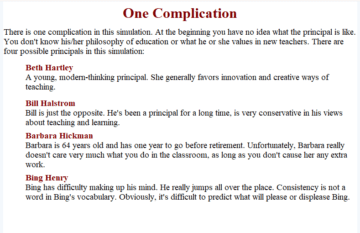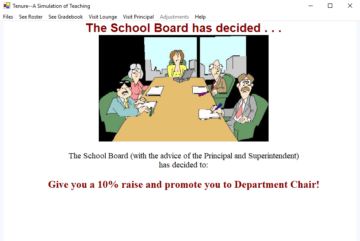What if you could play a game to find out what it feels like to be a first year teacher? What if, as your play the game, the Principal of the school that hired you kept an open channel of communication and let you know of the decisions he appreciated and the ones he was not too sure about? Would going into a practicum feel less terrifying? Or would you disregard the experience as nothing more than a Multiple Choice Answer quiz?

There are many games related to war, business, terrorism, however there are few that provide a commentary on the education system itself. Many videogames have been built for the purpose of education, such as ClueFinders (The Learning Company, 1998), while others which were made for a different audience, for instance Second Life (Linden Lab, 2003), have found their way into the school classroom. However, if one tries to find videogames about education rather than for education, the search does not lead to fruitful results. This could be because the audience for these games may be highly limited.
I came across Tenure (Gaede, 1975) in a reading for my cyberliterature class. It was mentioned by Ian Bogost on his seminal paper(2007) on procedural rhetoric, a technique employed by videogames and other computational systems where they make arguments using the computational process and interactivity. Owen Gaede created Tenure in 1975 as a simulation of first year teaching life for new teachers. The player is a new teacher who is looking for a job. The game was originally designed for a Plato system (older than Windows) and Bogost has been able to make it compatible with Windows using one of the earliest .NET frameworks. Instructions on downloading the game can be found at Tenure Instructions.
The Game
As mentioned earlier, the player is a new teacher, seeking a teaching job. The game starts off with an interview with the principal and based on the answer to his questions, the teacher may get an offer to teach at his school. The goal of the game is to survive situations in the course of one year and perform well to be hired again for the next year. Depending on the player’s interaction with the game and choices made by her around seating arrangement, grading methodology, teaching philosophy and approach, collaboration with other teachers and the principal, interaction with parents, the teacher may be hired for another term, may be hired with an increase in pay, become a Department Head or not be hired at all for the next year. The game emphasizes the many challenges of teaching and the social and political aspects of the profession, such as peer and student relationships, and warns in the beginning that there are no right or wrong answers to many of the presented questions. For each scenario, a description and question are presented to the teacher with five possible options. The player can choose a response the aligns with her own teaching philosophy or she can try to match her responses to what would please her peers, students or the principal. The teacher can also review the performance of the students using the gradebook, go to the teachers’ lounge for coffee or visit the principal for advice.
I appreciated the various scenarios put forward by the game. As a preservice teacher who has not been in the classroom for a couple of years, my perception of my space of future work has been limited to the activities I would have to be part of – lesson planning, teaching, student interactions, staff meetings, etc. The classroom management part is something that can’t truly be practiced unless it is with real students. I felt Tenure provided a middle ground, presenting me possible options I could choose from and thinking of situations that I have not decided a lot of time to so far.
The Characters
The main characters are the principal, the teachers, and the students, with the parents playing a very small role.
The Students. Students are an integral part of Tenure as the choices of teaching style, grading system and day-to-day activities affect them directly. The player encounters one scenario that directly concerns one student, Jack, who has been coming late to class every day. The teacher can choose to talk to him in private or reprimand him in public among other options. In another scenario, two of the students are passing notes. The grades of each student are accessible through the gradebook and a combination of the teaching style, grading system, and student interactions determine the final grade. Thus, the students provide a link to the larger issue that a teacher might face in a school, making the teacher think about the consequences of her actions on her students.
The Teachers. As a first-year teacher at Middleton School, the player in Tenure is presented with all the responsibilities of teaching from deciding the grading format (fixed or curved), seating arrangement, such as chosen by students, assigned by the teacher, teaching style, lecture time, laboratory work, individual projects among others, and being part of the Teachers Union to more controversial scenarios of going on strike which would not please the principal. Continuing with the case of Jack mentioned above, if the player decides to speak to him privately, she finds out that the Math teacher, Mr. Green, does not finish class on time, leading to a further decision on how to address this problem. Thus, there are numerous factors that the teacher cannot control. Since the aim of the game is to not get fired and at minimum have the contract renewed for the second year, it is important to not only stay in the good books of the principal but also the other teachers and the students.
If you are wondering if I confronted Mr Green or talked to the Principal, I decided to go with talking to Mr Green, because I remember from the Code of Conduct for Teachers (Alberta Teachers Association, 2004), we are supposed to talk to our colleagues first rather than escalating the issue. I remember during my Laws and Ethics class when we were looking at the Code, it was emphasized to know it by heart. We weren’t given short scenarios to test our reasoning with and Tenure provided a good practice.

The Principal. The principal is the mystery figure in Tenure. The game starts off by describing the characteristics of four kinds of principals that the first-year teacher can have. They vary in their teaching philosophy, intervention in teaching and view on grades. The principal is the one who conducts interviews with the teacher, hires her, recommends her to the Board of Education for another contract and sends feedback to the teacher in the form of notes for some decisions. It is important to keep him happy to have a chance of being hired again. The player can take into consideration who they think the principal is while making choices throughout the game. It is revealed at the end of the game which one she actually got.
Interaction
The interaction in Tenure progresses through a series of multiple choice questions associated with text-based scenarios. Only one of the choices can be selected. Ryan (2006) analyzes the different kinds of interactivity that are possible within videogames. Tenure is an internal-ontological game, that is , when the player represents an avatar in the game and affect the fate of the avatar as the novice teacher. Internal-ontological games tend to absorb the player more deeply in their storyline due to the connection with a character, whose fate is in the player’s hands. Hence, it is not surprising that I found myself absorbed in Tenure, irrespective of the multiple-based choice gameplay.

So what does this game try to portray?
Bogost (2007) defined procedural rhetoric as “the art of persuasion through rule-based representations and interactions rather than the spoken word, writing, images, or moving pictures” (pp. ix). Thus, the whole game itself conveys some kind of message. Bogost (2007) analyzed Tenure in terms of procedural rhetoric and argued that the multiple scenarios in the game challenge the belief that education of students is only driven by pedagogical goals, while in truth, there are many other factors such as the relationship with the teacher, the relationship between teachers, and personal budgets, that affect learning. Every decision made by the player affect the attitudes of other characters in the game. As Bogost (2007) aptly puts, “personal politics indelibly mark the learning experience” (pp 2), throughout the game, Tenure shows that the school system involves keeping many people as happy as possible, the principal being the focus of attention as he affects the professional career of the teacher most heavily.
Conclusion

In Tenure, the player slips into the shoes of a first-year teacher and tries to tackle the challenges tat come with the job. The principal is a key player in the life of the teacher as he makes important decisions such as hiring and salary, while also overseeing that his team of teachers can work well together. It succeeds in confirming the message that teaching is a social profession, involving many characters and monetary restrictions, which often means working for a system that a teacher might not personally agree with.
Another game related to the educational system is No Pineapples Left Behind (Subaltern Games, 2016), , a strategy game where the player is the principal of nine different schools. If you would like to read my views on it, let me know!
If you would like to try out Tenure, Tenure Instructions is the file with instructions to set it up on a Windows machine. Have fun! 🙂
References
Bogost, I. (2007). Persuasive games: The expressive power of videogames. MIT Press.
Gaeda, O. (1975). Tenure [videogame]. Minneapolis: Control Data Corporation. Retrieved from http://bogost.com/writing/blog/tenure-the-game/
Linden Lab. (2003). Second Life [videogame]. San Francisco: Linden Lab.
Ryan, M. (2006). Toward an Interactive Narratology. In Avatars of Story (pp. 97-125). University of Minnesota Press. Retrieved from http://www.jstor.org.login.ezproxy.library.ualberta.ca/stable/10.5749/j.ctttv622.9
Subaltern Games. (2016). No pineapple left behind [videogame]. Boston: Subaltern Games.
The Learning Company (1999). The ClueFinders 3rd Grade Adventures [videogame]. Cambridge, Massachusetts: The Learning Company.
Feature image from
